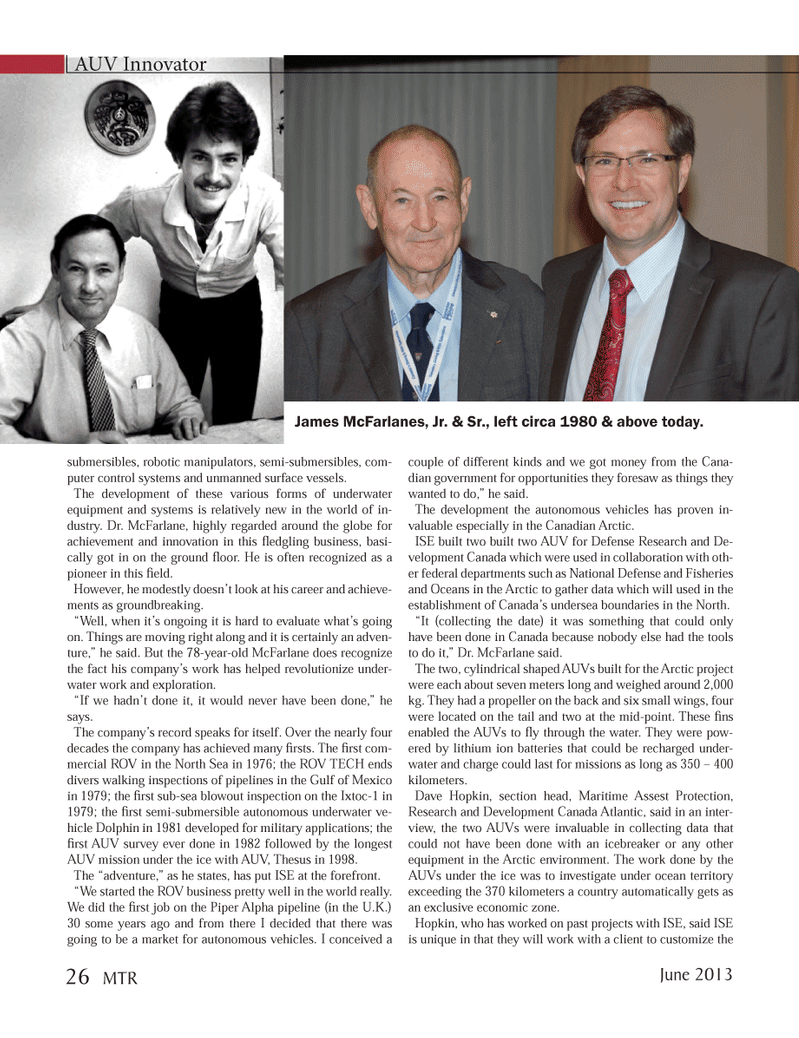
Page 26: of Marine Technology Magazine (June 2013)
AUV Operations
Read this page in Pdf, Flash or Html5 edition of June 2013 Marine Technology Magazine
submersibles, robotic manipulators, semi-submersibles, com-puter control systems and unmanned surface vessels. The development of these various forms of underwater equipment and systems is relatively new in the world of in- dustry. Dr. McFarlane, highly regarded around the globe for achievement and innovation in this ß edgling business, basi- cally got in on the ground ß oor. He is often recognized as a pioneer in this Þ eld.However, he modestly doesnÕt look at his career and achieve- ments as groundbreaking.ÒWell, when itÕs ongoing it is hard to evaluate whatÕs going on. Things are moving right along and it is certainly an adven- ture,Ó he said. But the 78-year-old McFarlane does recognize the fact his companyÕs work has helped revolutionize under- water work and exploration. ÒIf we hadnÕt done it, it would never have been done,Ó he says.The companyÕs record speaks for itself. Over the nearly four decades the company has achieved many Þ rsts. The Þ rst com- mercial ROV in the North Sea in 1976; the ROV TECH ends divers walking inspections of pipelines in the Gulf of Mexico in 1979; the Þ rst sub-sea blowout inspection on the Ixtoc-1 in 1979; the Þ rst semi-submersible autonomous underwater ve- hicle Dolphin in 1981 developed for military applications; the Þ rst AUV survey ever done in 1982 followed by the longest AUV mission under the ice with AUV, Thesus in 1998. The Òadventure,Ó as he states, has put ISE at the forefront. ÒWe started the ROV business pretty well in the world really. We did the Þ rst job on the Piper Alpha pipeline (in the U.K.) 30 some years ago and from there I decided that there was going to be a market for autonomous vehicles. I conceived a couple of different kinds and we got money from the Cana- dian government for opportunities they foresaw as things they wanted to do,Ó he said. The development the autonomous vehicles has proven in- valuable especially in the Canadian Arctic. ISE built two built two AUV for Defense Research and De- velopment Canada which were used in collaboration with oth- er federal departments such as National Defense and Fisheries and Oceans in the Arctic to gather data which will used in the establishment of CanadaÕs undersea boundaries in the North. ÒIt (collecting the date) it was something that could only have been done in Canada because nobody else had the tools to do it,Ó Dr. McFarlane said. The two, cylindrical shaped AUVs built for the Arctic project were each about seven meters long and weighed around 2,000 kg. They had a propeller on the back and six small wings, four were located on the tail and two at the mid-point. These Þ ns enabled the AUVs to ß y through the water. They were pow- ered by lithium ion batteries that could be recharged under- water and charge could last for missions as long as 350 Ð 400 kilometers.Dave Hopkin, section head, Maritime Assest Protection, Research and Development Canada Atlantic, said in an inter- view, the two AUVs were invaluable in collecting data that could not have been done with an icebreaker or any other equipment in the Arctic environment. The work done by the AUVs under the ice was to investigate under ocean territory exceeding the 370 kilometers a country automatically gets as an exclusive economic zone. Hopkin, who has worked on past projects with ISE, said ISE is unique in that they will work with a client to customize the AUV Innovator James McFarlanes, Jr. & Sr., left circa 1980 & above today. June 201326 MTRMTR #5 (18-33).indd 26MTR #5 (18-33).indd 266/3/2013 1:04:40 PM6/3/2013 1:04:40 PM

 25
25

 27
27
